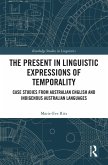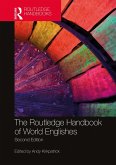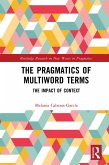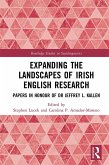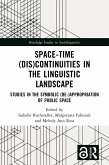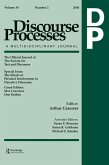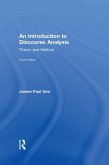Marie-Eve Ritz
The Present in Linguistic Expressions of Temporality (eBook, ePUB)
Case Studies from Australian English and Indigenous Australian Languages
41,95 €
41,95 €
inkl. MwSt.
Sofort per Download lieferbar

21 °P sammeln
41,95 €
Als Download kaufen

41,95 €
inkl. MwSt.
Sofort per Download lieferbar

21 °P sammeln
Jetzt verschenken
Alle Infos zum eBook verschenken
41,95 €
inkl. MwSt.
Sofort per Download lieferbar
Alle Infos zum eBook verschenken

21 °P sammeln
Marie-Eve Ritz
The Present in Linguistic Expressions of Temporality (eBook, ePUB)
Case Studies from Australian English and Indigenous Australian Languages
- Format: ePub
- Merkliste
- Auf die Merkliste
- Bewerten Bewerten
- Teilen
- Produkt teilen
- Produkterinnerung
- Produkterinnerung

Bitte loggen Sie sich zunächst in Ihr Kundenkonto ein oder registrieren Sie sich bei
bücher.de, um das eBook-Abo tolino select nutzen zu können.
Hier können Sie sich einloggen
Hier können Sie sich einloggen
Sie sind bereits eingeloggt. Klicken Sie auf 2. tolino select Abo, um fortzufahren.

Bitte loggen Sie sich zunächst in Ihr Kundenkonto ein oder registrieren Sie sich bei bücher.de, um das eBook-Abo tolino select nutzen zu können.
This book offers an examination of Present Time Expressions (PTEs), illustrating how an informed understanding of their semantic and pragmatic representations can offer unique insights into temporal systems of languages.
- Geräte: eReader
- mit Kopierschutz
- eBook Hilfe
Andere Kunden interessierten sich auch für
![The Present in Linguistic Expressions of Temporality (eBook, PDF) The Present in Linguistic Expressions of Temporality (eBook, PDF)]() Marie-Eve RitzThe Present in Linguistic Expressions of Temporality (eBook, PDF)41,95 €
Marie-Eve RitzThe Present in Linguistic Expressions of Temporality (eBook, PDF)41,95 €![The Routledge Handbook of World Englishes (eBook, ePUB) The Routledge Handbook of World Englishes (eBook, ePUB)]() The Routledge Handbook of World Englishes (eBook, ePUB)46,95 €
The Routledge Handbook of World Englishes (eBook, ePUB)46,95 €![The Pragmatics of Multiword Terms (eBook, ePUB) The Pragmatics of Multiword Terms (eBook, ePUB)]() Melania Cabezas-GarcíaThe Pragmatics of Multiword Terms (eBook, ePUB)41,95 €
Melania Cabezas-GarcíaThe Pragmatics of Multiword Terms (eBook, ePUB)41,95 €![Expanding the Landscapes of Irish English Research (eBook, ePUB) Expanding the Landscapes of Irish English Research (eBook, ePUB)]() Expanding the Landscapes of Irish English Research (eBook, ePUB)41,95 €
Expanding the Landscapes of Irish English Research (eBook, ePUB)41,95 €![Space-Time (Dis)continuities in the Linguistic Landscape (eBook, ePUB) Space-Time (Dis)continuities in the Linguistic Landscape (eBook, ePUB)]() Space-Time (Dis)continuities in the Linguistic Landscape (eBook, ePUB)41,95 €
Space-Time (Dis)continuities in the Linguistic Landscape (eBook, ePUB)41,95 €![The Effects of Personal Involvement in Narrative Discourse (eBook, ePUB) The Effects of Personal Involvement in Narrative Discourse (eBook, ePUB)]() The Effects of Personal Involvement in Narrative Discourse (eBook, ePUB)30,95 €
The Effects of Personal Involvement in Narrative Discourse (eBook, ePUB)30,95 €![An Introduction to Discourse Analysis (eBook, ePUB) An Introduction to Discourse Analysis (eBook, ePUB)]() James Paul GeeAn Introduction to Discourse Analysis (eBook, ePUB)46,95 €
James Paul GeeAn Introduction to Discourse Analysis (eBook, ePUB)46,95 €-
-
-
This book offers an examination of Present Time Expressions (PTEs), illustrating how an informed understanding of their semantic and pragmatic representations can offer unique insights into temporal systems of languages.
Dieser Download kann aus rechtlichen Gründen nur mit Rechnungsadresse in A, B, BG, CY, CZ, D, DK, EW, E, FIN, F, GR, HR, H, IRL, I, LT, L, LR, M, NL, PL, P, R, S, SLO, SK ausgeliefert werden.
Produktdetails
- Produktdetails
- Verlag: Taylor & Francis
- Seitenzahl: 260
- Erscheinungstermin: 30. November 2023
- Englisch
- ISBN-13: 9781003803348
- Artikelnr.: 69249913
- Verlag: Taylor & Francis
- Seitenzahl: 260
- Erscheinungstermin: 30. November 2023
- Englisch
- ISBN-13: 9781003803348
- Artikelnr.: 69249913
- Herstellerkennzeichnung Die Herstellerinformationen sind derzeit nicht verfügbar.
Marie-Eve Ritz is currently a research fellow at the University of Western Australia, Australia.
Contents, List of Figures, List of Tables, Preface, Acknowledgements, Abbreviations, Chapter 1: Introduction, 1.0 Introduction: goals and motivation for the present study, 1.1 Tense: an overview and brief history of the treatment of tense and of the importance of the Present, 1.2 Outline of the book, Chapter 2: Tense, aspect and adverbials: overview of key semantic and pragmatic theories, 2.0 Introduction, 2.1 Aspect, 2.1.1 Some issues with the Vendlerian categorisation, 2.1.2 Aspectual composition, 2.1.3 The structure of eventualities: aspectual shift and coercion, 2.2 Tense and Aspect in Discourse Representation Theory, 2.2.1 Temporal adverbs and adverbial phrases in DRT, 2.3 The discourse-pragmatics of tense and aspect: temporal inferences of rhetorical relations, 2.4 SDRT: discussion and extensions, 2.5 Conclusion, Chapter 3: The temporal semantics and pragmatics of 'now' vs 'then': overview of current theories, 3.0 Introduction, 3.1 From now as indexical to now as anaphor, 3.2 Is the sense of contrast part of the semantics of now?, 3.3 Now and temporal progression, 3.4 Now and then in English and cross-linguistically, 3.5 'Now' and 'then' in languages other than English, 3.6 Now and then: discourse marking functions, 3.7 Summary and conclusions, Chapter 4 'Now' in absolute and relative uses: case studies, 4.0 Introduction, 4.1 Overview of 'now/then' temporal clitics in Australian Indigenous languages, 4.1.1 The clitic =rru in Panyjima, 4.1.2 The clitic =biyang in Jaminjung, 4.1.3 The clitic =lku in Walpiri and Warlmanpa: typological considerations, 4.2. The clitic =rru in Martuthunira, 4.2.1 The clitic =rru and the Martuthinira TAM system, 4.2.2 Detailed analysis of =rru in Martuthunira, 4.2.2.1 =rru in discourse: rhetorical analysis, 4.2.2.2 =rru and contrast, 4.3 Discussion and conclusion, Chapter 5: Shifted tenses: the Historical Present, 5.0 Introduction, 5.1 Early discussion: the HP as a 'dramatic or vivid' tense and the nature of the English Simple Present, 5.2 Do we need a dual context to represent the HP?, 5.3 The role of tense vs aspect and discourse relations, 5.4 The Present: a combination of deictic and relative meaning? The case of 'double access' sentences, 5.5 The Narrative/Historical Present and perfectivity: some cross linguistic observations, 5.6 Conclusions and sketch of an alternative proposal, Chapter 6: Present tenses and shifted uses in discourse: case studies, 6.0 Introduction, 6.1 A Narrative Future? Telling a story in Martuthunira, 6.2 The Narrative Present Perfect and the Historical Present: telling a story in Australian English, 6.2.1 The Narrative Present Perfect in two genres, 6.2.2 The Simple Past, the Historical Present and the Narrative Present Perfect: understanding the differences, 6.2.3 Pragmatic effects of shifted present tenses: vividness, evidentiality and mirativity, 6.3 The shifted present domain: discussion, Chapter 7: Towards a theory of the linguistic present, 7.0 Introduction, 7.1 What's in a 'now'?, 7.2 What's in a present?,7.3 Presentness: absolute and relative, 7.4 The pretence, 7.5 Conclusion, Chapter 8: What now?, 8.0 Introduction, 8.1 Deixis, anaphora; relative and absolute tense, 8.2 Empirical testing of speakers' perceptions of 'now' and the present time, 8.3 Emprical studies of figurative language use, 8.4 Concluding: further research
Contents, List of Figures, List of Tables, Preface, Acknowledgements, Abbreviations, Chapter 1: Introduction, 1.0 Introduction: goals and motivation for the present study, 1.1 Tense: an overview and brief history of the treatment of tense and of the importance of the Present, 1.2 Outline of the book, Chapter 2: Tense, aspect and adverbials: overview of key semantic and pragmatic theories, 2.0 Introduction, 2.1 Aspect, 2.1.1 Some issues with the Vendlerian categorisation, 2.1.2 Aspectual composition, 2.1.3 The structure of eventualities: aspectual shift and coercion, 2.2 Tense and Aspect in Discourse Representation Theory, 2.2.1 Temporal adverbs and adverbial phrases in DRT, 2.3 The discourse-pragmatics of tense and aspect: temporal inferences of rhetorical relations, 2.4 SDRT: discussion and extensions, 2.5 Conclusion, Chapter 3: The temporal semantics and pragmatics of 'now' vs 'then': overview of current theories, 3.0 Introduction, 3.1 From now as indexical to now as anaphor, 3.2 Is the sense of contrast part of the semantics of now?, 3.3 Now and temporal progression, 3.4 Now and then in English and cross-linguistically, 3.5 'Now' and 'then' in languages other than English, 3.6 Now and then: discourse marking functions, 3.7 Summary and conclusions, Chapter 4 'Now' in absolute and relative uses: case studies, 4.0 Introduction, 4.1 Overview of 'now/then' temporal clitics in Australian Indigenous languages, 4.1.1 The clitic =rru in Panyjima, 4.1.2 The clitic =biyang in Jaminjung, 4.1.3 The clitic =lku in Walpiri and Warlmanpa: typological considerations, 4.2. The clitic =rru in Martuthunira, 4.2.1 The clitic =rru and the Martuthinira TAM system, 4.2.2 Detailed analysis of =rru in Martuthunira, 4.2.2.1 =rru in discourse: rhetorical analysis, 4.2.2.2 =rru and contrast, 4.3 Discussion and conclusion, Chapter 5: Shifted tenses: the Historical Present, 5.0 Introduction, 5.1 Early discussion: the HP as a 'dramatic or vivid' tense and the nature of the English Simple Present, 5.2 Do we need a dual context to represent the HP?, 5.3 The role of tense vs aspect and discourse relations, 5.4 The Present: a combination of deictic and relative meaning? The case of 'double access' sentences, 5.5 The Narrative/Historical Present and perfectivity: some cross linguistic observations, 5.6 Conclusions and sketch of an alternative proposal, Chapter 6: Present tenses and shifted uses in discourse: case studies, 6.0 Introduction, 6.1 A Narrative Future? Telling a story in Martuthunira, 6.2 The Narrative Present Perfect and the Historical Present: telling a story in Australian English, 6.2.1 The Narrative Present Perfect in two genres, 6.2.2 The Simple Past, the Historical Present and the Narrative Present Perfect: understanding the differences, 6.2.3 Pragmatic effects of shifted present tenses: vividness, evidentiality and mirativity, 6.3 The shifted present domain: discussion, Chapter 7: Towards a theory of the linguistic present, 7.0 Introduction, 7.1 What's in a 'now'?, 7.2 What's in a present?,7.3 Presentness: absolute and relative, 7.4 The pretence, 7.5 Conclusion, Chapter 8: What now?, 8.0 Introduction, 8.1 Deixis, anaphora; relative and absolute tense, 8.2 Empirical testing of speakers' perceptions of 'now' and the present time, 8.3 Emprical studies of figurative language use, 8.4 Concluding: further research

